5 Ultracontemporary Artists Redefining the Korean Art Landscape
The dynamic South Korean art scene is quickly becoming one of the most prominent globally, blending rich traditions with cutting-edge innovation. And...
Carlotta Mazzoli 13 January 2025
In today’s world, the environment and its protection are some of the most pressing matters we are forced to address. Here are five artists at the forefront of this discourse.
Contemporary art is usually at the vanguard when it comes to addressing and discussing pressing matters, and artists are generally among the first to recognize the importance of such discourses and to use their work to raise awareness. With climate change being one of the most pressing issues of our days, it comes as no surprise that contemporary artists are turning their interests towards the environment and its protection and embracing them as their core values.
However, the environment has been a recurring theme in many artists’ productions for several years now, and its recent popularity is helping discover and rediscover artists who have worked around this theme for decades. With their significant contributions to the intersection of art and the environment, these artists have used their talents to explore, critique, and raise awareness about ecological challenges since the 1970s, paving the way for today’s artists and practices.
The birth of environmental art can be traced back to the ‘60s when it was closely related to Land Art and Arte Povera, without it being entirely focused on the climate crisis yet. Nowadays, the environment is present at several different levels in the production of contemporary artists, from those specifically working around ecological issues, often involving political instances as well, to those just marginally touching upon this subject, as part of a broader discourse around today’s society and values.
In this article, we gathered 5 representative artists who work with the environment, tracing an ideal line from the movement’s founders to the most recent instances. As we navigate an increasingly complex ecological landscape, these artists offer valuable insights and perspectives that encourage us to become better stewards of the Earth and its ecosystems, fostering a brighter and more sustainable future for all.
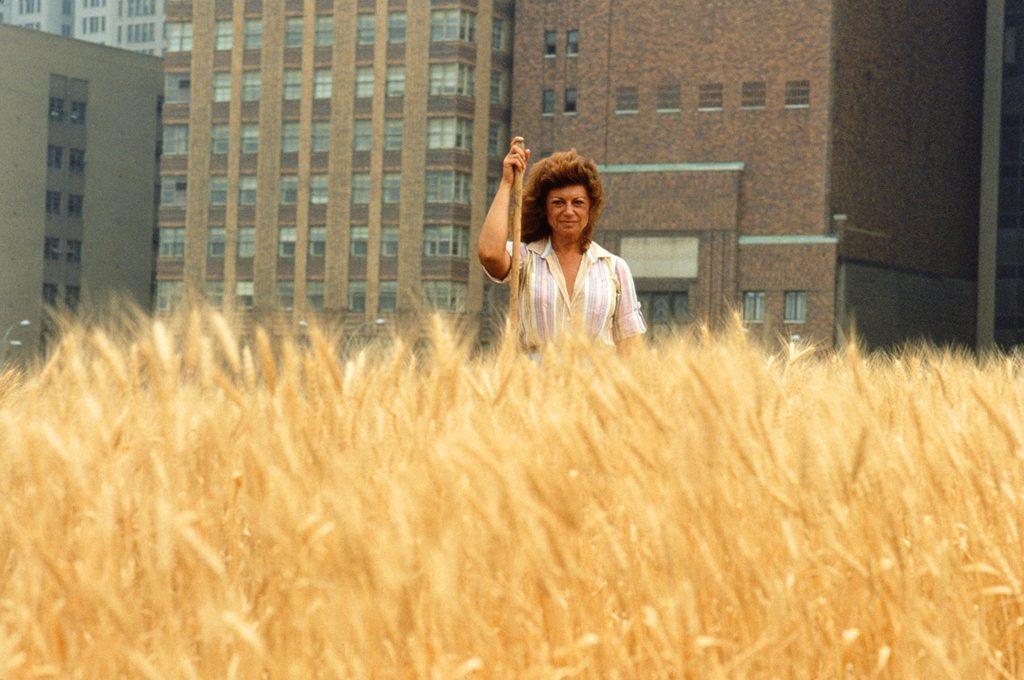
Agnes Denes, Wheatfield – A Confrontation, 1982, Battery Park Landfill, New York City, NY, USA. Credit John McGrail, courtesy Leslie Tonkonow Artworks + Projects.
The Hungarian-born American conceptual artist Agnes Denes (b. 1931) is renowned for her thought-provoking eco-art, which marries the realms of art, science, and environmental consciousness. Her work has consistently challenged the status quo and compelled audiences to reconsider humanity’s relationship with the natural world.
Denes’ art often integrates science, philosophy, linguistics, psychology, poetry, and history, creating a unique fusion of intellectual exploration and environmental advocacy. Through her works, she invites us to reflect on the delicate equilibrium between human civilization and the natural world.
Perhaps one of Denes’ most iconic pieces is Wheatfield—A Confrontation from 1982. In the heart of bustling Manhattan, the artist transformed an empty lot into a two-acre wheat field, which she (together with assistants and volunteers) maintained for four months until it was harvested in August of the same year. Providing a startling juxtaposition of rural agriculture amidst the urban sprawl, this powerful installation served as a stark reminder of the human impact on nature and land use.
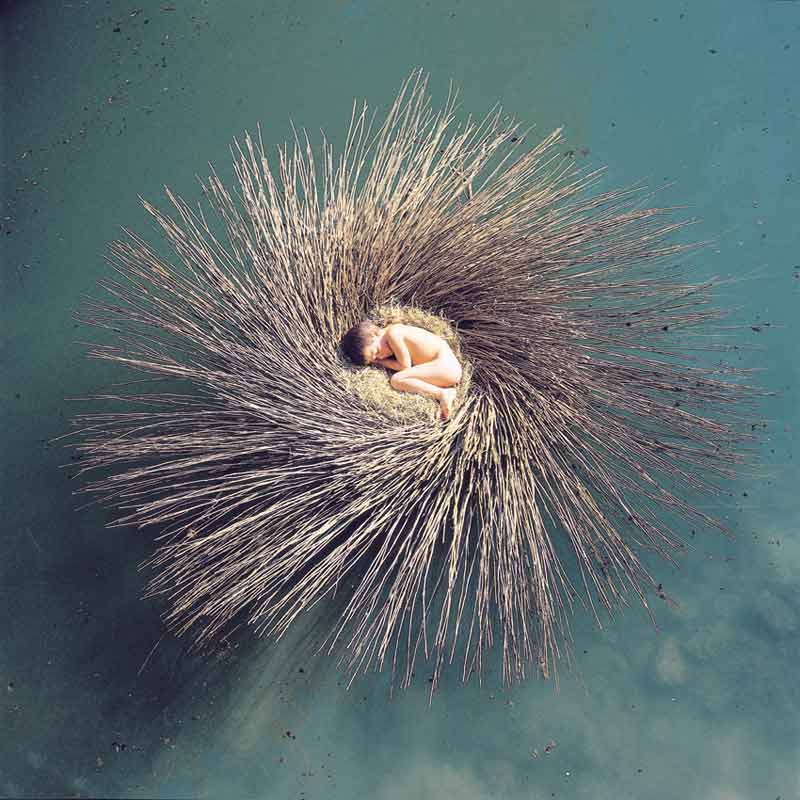
Nils-Udo, OVO, album cover for Peter Gabriel’s album, 2000. Courtesy of Peter Gabriel and the artist.
Another pioneer in the environment art movement is Nils-Udo (b. 1937). The German artist has been renowned since the 1960s for creating site-specific environmental art installations that celebrate the intrinsic beauty of the natural world. His work serves as a testament to the profound connection between humans and their environment, reminding us of our integral role in preserving the planet’s biodiversity.
Nils-Udo often employs natural materials to craft sculptures and installations that seamlessly integrate with their surroundings. His art is a harmonious dialogue with the environment, emphasizing the importance of preserving its beauty for future generations. Working with nature and in nature, Nils-Udo’s pieces are ephemeral and can disappear with time, reabsorbed by their surroundings and by the same nature they wish to investigate. For this reason, the artist turned to photography, to be able to document and preserve his works in time. His creations stand as a testament to the delicate balance that must be maintained for the well-being of our planet.
Among his most famous works, we can find the installation OVO (2000), which Udo created as the cover design for Peter Gabriel’s album OVO. In the nest-like structure lays a child (the son of Susie Millns, an employee of Real World Studio where the album was recorded), creating a parallel between the natural elements and the child’s pureness. The installation was later moved into Peter Gabriels’s garden nearby and eventually set on fire by the musician’s gardener, to dispose of it, underlying the transient nature of Nils-Udo’s work.
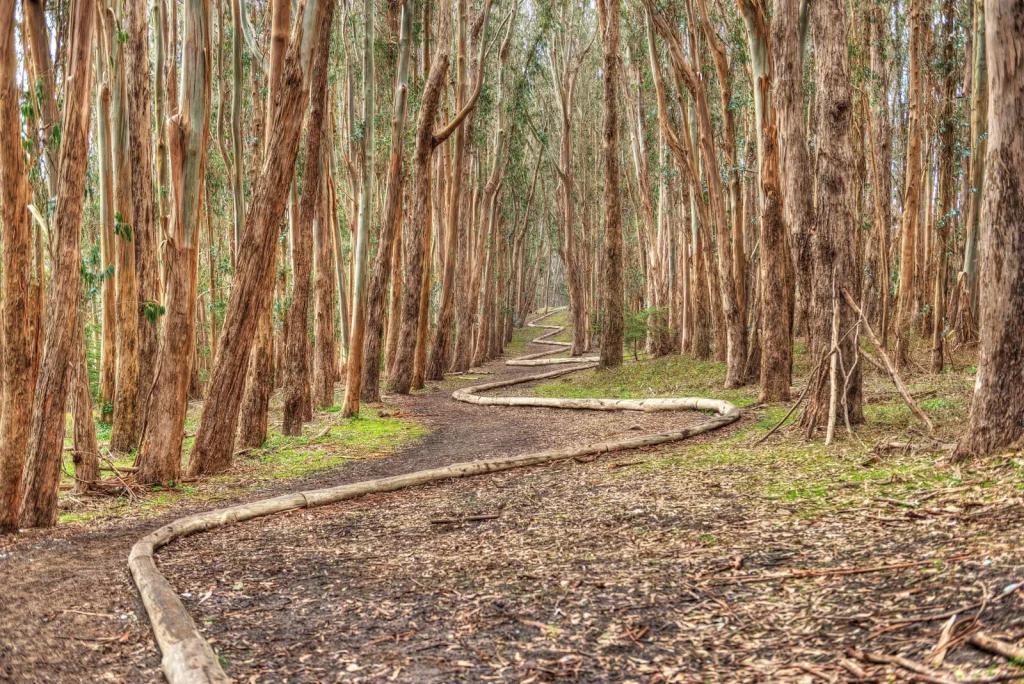
Andy Goldsworthy, Wood Line, 2010–11, in the Presidio, San Francisco, CA, USA. © Hollandog/Dreamstime.com.
A generation younger, the British artist Andy Goldsworthy (b. 1956) is yet another artist celebrated for his ephemeral and site-specific land art. His creations revolve around the transient nature of the environment and the harmonious interaction between nature and art. When he was a teenager, Goldsworthy spent a few years working as a farm laborer in rural England before going on to study art at Bradford College of Art and later Preston Polytechnic. This experience deeply influenced his practice, as he utilizes materials found in the natural world, such as stones, leaves, twigs, and even ice, to construct intricate sculptures that are often exposed to the elements, allowing nature to shape and transform them over time. In a 2007 interview with The Daily Telegraph, the artist said:
“I think it’s incredibly brave to be working with flowers and leaves and petals. But I have to: I can’t edit the materials I work with. My remit is to work with nature as a whole.”
Alastair Sooke, He’s got the whole world in his hands, The Daily Telegraph, London, 24 March 2007.
The impermanence of Goldsworthy’s art serves as a poignant reminder of the beauty and fragility of the natural world. His creations encapsulate fleeting moments in the environment, urging us to appreciate and preserve the ephemeral aspects of life. Unlike other artists working with Nature, Goldsworthy’s works are usually small in scale and they often merge seamlessly with their surroundings, highlighting the profound unity between human creativity and the environment.
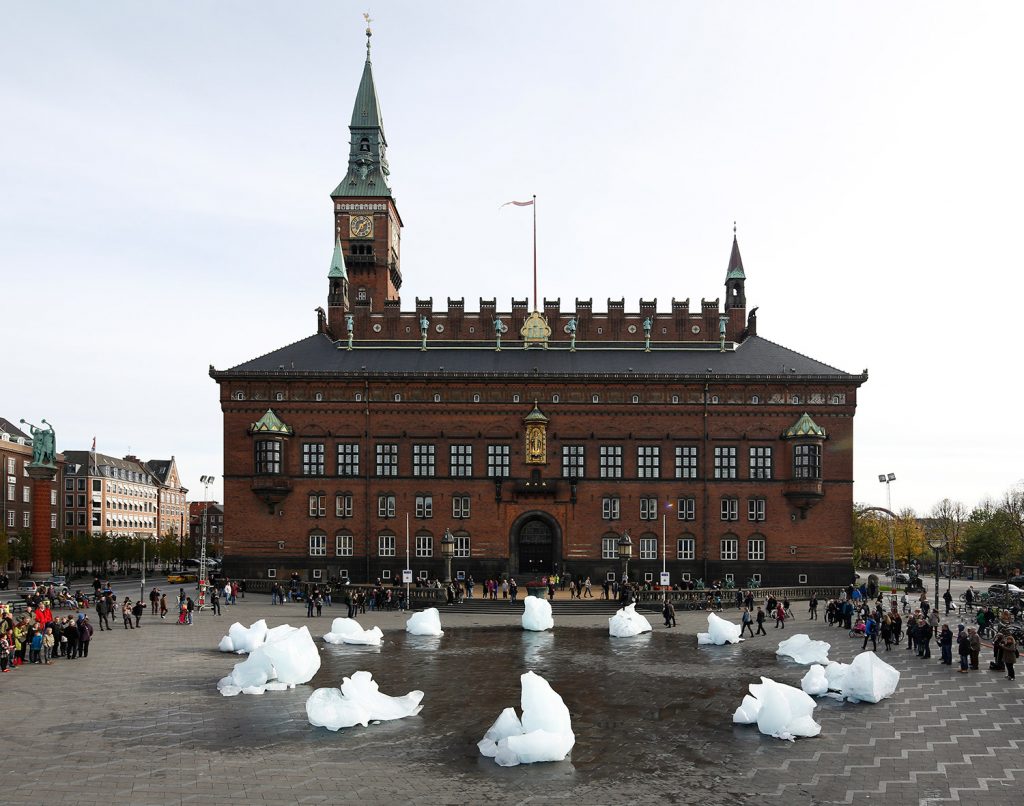
Olafur Eliasson, Ice Watch, 2014, City Hall Square, Copenhagen, Denmark. Courtesy of the artist.
Olafur Eliasson (b. 1967), a Danish-Icelandic artist, specializes in creating immersive installations that engage our senses and explore our connection to the environment. His works often incorporate natural elements like light, water, and temperature to provide viewers with unique sensory experiences.
One of Eliasson’s most iconic pieces is The Weather Project, exhibited in 2003 at the Tate Modern in London. This installation featured a massive artificial sun, shrouded in mist, creating an illusion of an otherworldly, atmospheric environment. Visitors were invited to bask in the radiant glow, evoking a profound sense of wonder and connection to the natural world.
Eliasson’s art blurs the line between art and science, prompting us to explore our relationship with the environment on a sensory and emotional level. His creations evoke powerful emotions, compelling us to contemplate our role in shaping the environment and our responsibility to protect it.
In that regard, another key work by the Danish artist is Ice Watch. Presented in various locations throughout Europe, such as Copenhagen, Paris, and London, the work was described as a physical wake-up call. The work consisted of twelve large blocks of ice, cast off from the Greenland ice sheet, and placed in the European cities to melt down. The aim of the work was clear: the climate crisis is changing the environment and glaciers are melting. By getting in direct contact with this reality, the artist urges every one of us to rethink our lifestyles and act to preserve the Planet.
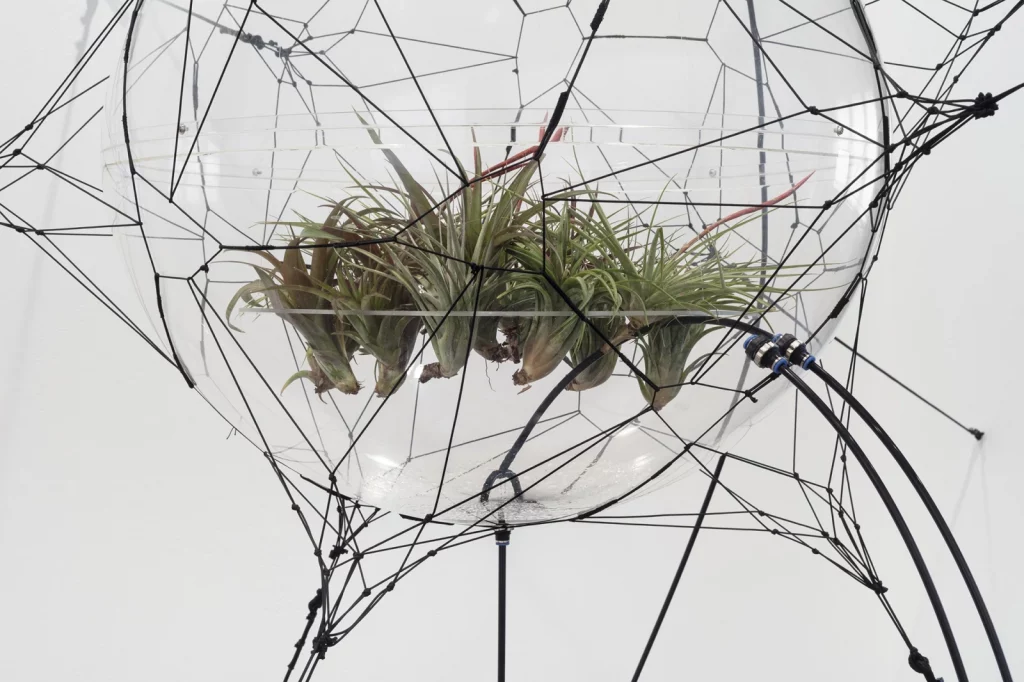
Tomás Saraceno, Biosphere 06, 2009, acrylic, rope, nylon monofilament, plants, air pressure regulator system, hydration system, overall installed dimensions variable. Courtesy of Tanya Bonakdar Gallery.
The youngest among the artists analyzed here, Tomás Saraceno (b. 1973) is an Argentinian artist, whose work ventures into the realms of environmental art and speculative science. It challenges conventional notions of architecture and human habitation by exploring the possibilities of living in the Earth’s atmosphere. Saraceno’s imaginative installations, often constructed from translucent materials, resemble otherworldly ecosystems suspended in mid-air. Aiming at finding possible alternatives to the current “Capitalocene” era and the models imposed on society by late capitalism, Saraceno’s installations and sculptures propose a renewed idea of community and ecosystems, one that is looking towards the future rather than to the past.
One of Saraceno’s most notable works is Biosphere 2.0, a project that envisions a self-sustaining habitat floating in the atmosphere, fostering the dialogue about sustainable living and our responsibility to the planet. Through his art, Saraceno encourages us to reconsider the boundaries of our environment and the potential for more harmonious coexistence with the atmosphere and the planet as a whole. Saraceno’s visionary installations provoke thought about our relationship with the environment, inviting us to envision a future where human habitation aligns with ecological harmony.
DailyArt Magazine needs your support. Every contribution, however big or small, is very valuable for our future. Thanks to it, we will be able to sustain and grow the Magazine. Thank you for your help!